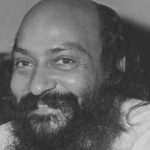Radhika’s fourth and last part… working and meditating in the Pune commune.

Dhamma
Osho’s dhamma is difficult to grasp and describe. At least for me. I think his dhamma is all and everything he ever said or ignited. I don’t feel like saying: he ever “did.” He is the non-doer he always pointed out to us he was. If I had to condense it to one subject only, I probably would say that it is his brilliant contribution in creating the new man. The concept of the new man first came into my life when reading Nietzsche’s Thus Spoke Zarathustra at fourteen years old. I immediately adopted the philosopher’s declaration that man is the bridge between animal and god. But, at the same time – god was dead! I was really relieved to read that news. And I also understood clearly: if god was dead, then it is man himself who has to overcome his tense posture of bridging two different states of being. He has to grow into that divine state. To be a human being was just transitional. How delighted I was, when soon after my first arrival in Pune, Osho spoke many weeks on this very book by Nietzsche.
Speaking of Osho
And about Osho speaking on thousands of subjects to thousands of listeners: I always considered each discourse was him painting with words on an empty canvas. He began with his very first brush strokes, building the painting until it was perfect, and finally completed it with his ending words. No matter what subjects, stories, jokes, the answering of questions, comments on sutras or Zen anecdotes were included, it always felt to me like an immaculate piece in itself, all parts fitting perfectly together. Whenever I come across quotes as excerpts from his discourses or video clips, I always know how much larger the whole painting actually is. And when I hear people quote Osho to others, it makes me laugh. For whatever Osho has said, he has always said the very opposite of it also! To bring an Osho quote in the mission of explaining or even defending anything is hilarious. How I love my wild, wild master!
The ten thousand Buddhas
All sannyasins I have ever met were so precious to be with. There were likes and dislikes, understanding and misunderstanding, just as in normal life. The difference was that we all worked on our inner growth and were very much in love with the same man. To be part of Osho’s sangha was a special way of living. And it was easy to spot a sannyasin anywhere in the world when we were still wearing red. The signal-like red shades from head to toe spoke loudly. And the mala was so prominently visible. I had job interviews with it underneath my clothes, but the beads must have shown around my neck and there was sometimes sweat on my forehead considering that this could ruin my chances! But to my astonishment it often wasn’t a hindrance. There were so many sannyasins around at times that people must have somehow adjusted to it. We all felt connected to Osho by our outfit device and many of us didn’t take off their mala even at night. How shocked and sad I was when one day in Rajneeshpuram he announced for us the option to also wear other colours and put down the mala. I didn’t do so for many months to come and later always wished it back.
And this finally happened with the maroon robes in Pune Two! And how exquisite the gathering of the ten thousand Buddhas, all dressed in white for the evening meeting. Whatever we did during the day, we met in the evening to celebrate and meditate together with the master. He led us into the technique of gibberish and let-go, at the end of each meeting, and it was such an extraordinary experience! And the more we were guided by Osho in that practice every evening, the deeper the silence, the poetry, the love that was unfolding. We turned into a lake of consciousness, as he often commented.
Osho’s Glossy Magazine
Having trained as a graphic designer, in the late 1990s I enjoyed to help produce the Osho Times International (OTI) each month, together with a group of writers, editors, and two other page-makers. The three of us created all the pages of the glossy monthly magazine, sitting in an airy room in front of our computer work stations. Whenever a page or an article was finished, a print-out was placed on the wall until all pages were complete and ready for print. Following a final meticulous technical check-up, the data file went to a Mumbai company which delivered the printed magazine to the commune, while the rest was distributed to subscribers all over the world.
The Hindi Osho Times was located in the same building. And the Italian Osho Times was not produced in Italy but in the very room next to us, and many articles were translated right then and there into Italian. Having written for magazines and newspapers earlier, a few times I wrote articles for both issues. Each month was a venture regarding what text contents would be contributed and how to illustrate them. We three page-makers, right after the arrival of the fresh copies, always spent the afternoon proudly selling them in front of the commune’s bookshop.
Meeting Marilyn Monroe in Osho‘s library
Designing many articles for Osho Times International freely, I sometimes had to retrieve image material to illustrate various text contributions. One day I found that for a particular text a photograph of Marilyn Monroe would be perfect and that I knew in Osho’s library there would certainly be enough books to choose from. I received a form from the librarian on which I described my request and not much later found myself in white socks on the marbled path inside the mirrored narrow walkway, walled with colourful bookshelves behind pristine glass, leading into Osho’s library inside Lao Tzu house. I was dazzled at entering the main library space, which was brightly lit by daylight with a spectacular view of the jungle growth of the garden outside, while the humming of the air conditioning even seemed to deepen the silence inside the room.
On the large table, where I knew Osho sometimes sat for photos, several books were laid out on display. There she was, waiting for me, smiling her beautiful, beaming and vulnerable smile. While sifting through pages, I inevitably absorbed deeply Osho’s energy that was clearly present in the room – which almost made it difficult for me to focus on my task! All too quickly I had found the book providing the right photograph. With the large-size, weighty volume tucked under my arm I sauntered down the shiny aisle to finally slide into my sandals. Passing the peacocks and Lao Tzu gate, eventually walking onto the marbled pathways of the commune with fellow travellers buzzing gracefully about, I felt that I had just been visiting a supremely distinct realm.
Odyssey into the Chambers
We were also proud at Osho Times International to perfectly meet the printing deadline each month. As computers and programs were not yet running so smoothly and reliably as today, we occasionally had to work late in the evening. Even though we’d begun at nine in the morning, to continue after discourse was not tiring at all, because it was such a refreshing and renewing experience. One day, to complete the final check-up for all pages, one of the page-makers and I stayed late. We very much enjoyed working together. Sometimes we had to write technical notes to each other. One of us always created a piece of art by drawing lovely comic-like characters next to the note. At first, after reading, I disposed of them into my wastebasket to keep my desk clear and clean. But soon I began to collect these little treasures and still have them today. The artist had a room inside the commune, while I lived in a shared apartment outside.
That one night it had become very late when we had successfully completed the data file for delivery to the printer. By the time we said good-night it was one o’clock in the morning. After changing into my street clothes I climbed into a rickshaw near the front gate. I walked up the stairs of my flat, put my key into the lock to open the door. And it didn’t open. I tried, again and again, in different ways. The sannyasin with whom I shared the apartment had left that morning for a week in Goa. She must have somehow damaged the lock when leaving. It was past two in the morning when I walked back to the quiet street, trying to find a rickshaw. A friend was living nearby and surely I could stay overnight. I told the driver to wait while I was ringing the bell. Nothing, the bell didn’t work. I walked into the courtyard, calling his name. Everything stayed silent. We drove back to my apartment, I tried again, but the lock didn’t open. I had an idea. I would return to the commune and stay in the so-called Chambers. These were session rooms in the basement of Krishna House, equipped with mattresses, pillows and sheets. We drove towards the back gate, as this was the shortest way. While we were hurrying down the road I was surprised to suddenly see a group of about forty men, all dressed in the same light mustard-coloured robes walking past the rickshaw in a brisk way and very close formation.
I slid down from the back seat into the darkness of the rickshaw floor, so that all these men saw was an empty vehicle passing by at around four in the morning. I was quite happy when we arrived. I explained the situation to the guard at the back gate and he made a phone call. After quite a while the gate opened and I was accompanied to one of the chambers. It was five in the morning when I finally settled on a mattress there. My entire body was buzzing. After a short doze and having refreshed myself at the nearby showers I changed into my maroon robe. I listened to the sounds of the Dynamic Meditation emerging from Buddha Hall during my breakfast. And then I went straight back to my work station to begin with the next month’s magazine issue, smiling at my two workmates when they arrived at nine to start up their computers.
The Spiritual Man’s Playground
Apart from being busy becoming the new man, we participated in hundreds of activities provided by Osho, and contributing to the commune. We were all engaged in so many ways. I once made a list of my contributions. It is somewhere stashed away but I do recall that I sang soprano in a Gurdjieff Sacred Dances choir, appeared in a musical, participated regularly in operating the commune’s gigantic dishwashing machine, cleaned cooking pots in the kitchen, dressed fancy for the Osho carnival events, set up the rooms for Born Again groups and cleaned them afterwards, worked as a security guard at the gates and during discourse. I was a crosser for the food vouchers at different counters, a session giver at the Mystery School and I contributed a graphology survey for Mystic Rose participants before and after the group. And there was much more. And this was the case for so many sannyasins. We were simply continuously blooming, flowering in all possible directions.
The Samadhi
If Buddha Hall to me was a temple/spaceship, the Samadhi, where Osho’s ashes are kept, was the actual spaceship. Its coolness and elegance, the enormous round chandelier made of thousands of small crystals, reflecting in the glass walls in front of the greenery of the jungle outside. The silence and immense energy at the same time. And to walk through Osho’s library walkway to get there is so extraordinary. To sit meditating in his own walkway, at night, during full moon, for hours. Sitting in meditation inside the Samadhi itself I fell into such depths that on two occasions I almost fainted.
I have a repeating dream at night since many years: having visited the commune for some time, finally the day of departure has come. And I forget to walk inside the Samadhi one last time. It always makes me wake up from my dream. Sometimes I just go there in my inner vision. The small and steady sound of the air-conditioning is soothing, the thick and small, large and delicate leaves are swaying softly outside in a silent breeze. A few sunrays break through the thick of the jungle and meet and merge with the small lights reflecting on the glass wall. Feeling Osho present. This is actually the very spot where thirty-eight years ago I took sannyas in my dream.
With the exception of Ma Prem Gayan, a well-known former model and mentioned in Part 1, no particular names of persons or places are mentioned in this series, as it is not written as an autobiography, but rather glimpses of a spiritual journey together with Osho.
Illustration by the author – read the whole series: Jewels on the Path by Radhika





Comments are closed.